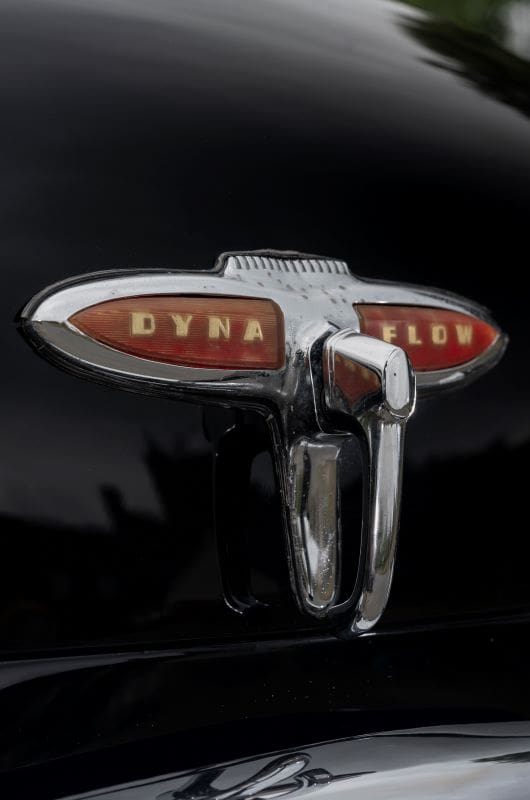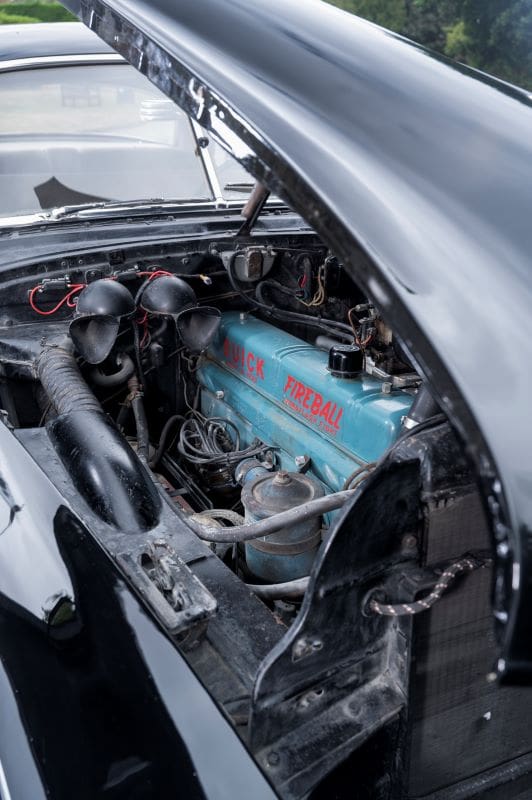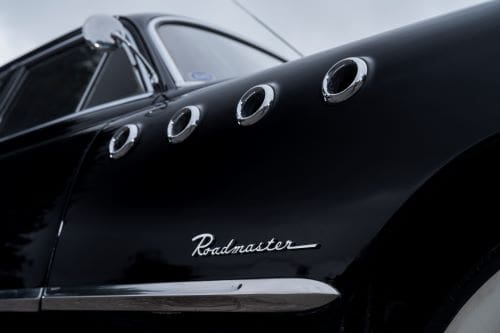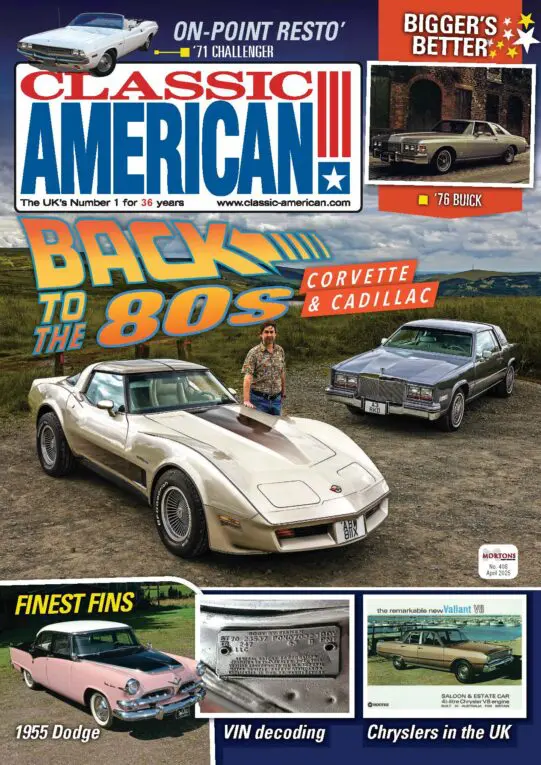Buick’s 1949 cars were a one-year-only design that were popular when new and remain enticing today, just ask Paul Traub who couldn’t resist buying this Roadmaster Sedan…

Words: Mike Renaut Photography: Matt Richardson
Paul Traub’s 1949 Buick Roadmaster is his first American car – and what a way to start! “I bought the Buick in 2019. In fact, it’s also my first classic car,” says Paul, “although I had a Fiat X1/9 when they were still fairly new and obviously that’s a classic today.” The Buick was advertised online, “I love the design of the 1940s and 1950s cars, but I’ve always found big tailfins to be a bit over the top; this bodywork is curved and far subtler. I really wanted a black car after seeing something like it in the film Goodfellas. There was also a similar age Buick convertible in the movie Rain Man and I really liked the Buick’s cockpit styling – that dashboard reminded of something from an aircraft. So I’d decided I wanted a Buick or a Cadillac Coupe de Ville.
Enjoy more Classic American reading in the monthly magazine.
Click here to subscribe & save.
“There’s a Facebook page for 1940s and 50s Buicks,” continues Paul, “and they’ve been especially useful in helping me find spares, I’ve needed a taillight gasket and a wiring harness for the taillights. The harness was a little trickier, taking six months to get one made, but so far nothing has been expensive. My local garage is run by a guy called Paul Harris and he’s very good and also happy to work on the Buick.”
This Roadmaster didn’t come with much in the way of paperwork, but from what there is we deduce it was at a car dealer in the Los Angeles area in early 2012 when it was sold, then registered in Corona to a Jerry Yung Case and wore licence plate 5TZDO72. Jerry sold the Buick in August 2018 and it came to the UK. “The car was imported by Nick Hutton of Blyth,” explains Paul, “who I believe is a broker for classic car dealerships.”

It takes an entire book to recount Buick’s full history, but the man who gave the world the first Buick automobile was David Dunbar Buick. His background was plumbing and he developed a method of fixing porcelain to cast iron which resulted in the white bathtub. In 1899 he sold his plumbing business to concentrate instead on producing twin-cylinder petrol engines under the name Buick Auto-Vim and Power Company. Along with two partners, he developed a valve-in-head engine and by 1903 the Buick Motor Company had a factory. Although there were experimental models produced as early as 1901, the first production car was only built and sold in summer 1904.
The following November the debt-ridden company was sold to the unusually named William Crapo Durant who turned the stock value of the company from $75,000 to $1.5-million within a year and made Buick America’s best-selling car. In 1908 Durant used Buick to found another company he called General Motors.
Buick’s first six-cylinder engine arrived in 1914, and within two years the company was producing more than 120,000 cars annually, with better than 200,000 sold in 1928. Buick eschewed V8 engines in favour of straight-eights, but while their engineering was often conservative, by 1933 Buick’s styling was beginning to sparkle under the influence of Harley Earl. For 1936, the cars were organised into four model designations that would be used for decades to come: Special, Century, Roadmaster and Limited; the Century named for its ability to top 100mph. In 1939 Buick introduced the industry’s first turn signals and entered the 1940s selling over 310,000 cars a year until the war stopped automobile production.
The Forty-Niners
Buick “looks fine for ’49” said the headline on the brochure which touted an “interior of fine fabrics and flawless metal finishings, stout-hearted chassis and the widest wheel rims in the industry”. New shock absorbers improved the ride. The 1949 Buicks were built at seven factories across the USA and numbered accordingly, so cars with serial number 150 were manufactured in Michigan, 250s in California and so on. Our feature car’s VIN begins 5525, which means it was born in the Wilmington, Delaware, plant. Model year production was the best yet at 398,482 cars − meaning 7.7 per cent of market share − and four-door Roadmasters made up 54,674 of that total, plus another 568 that were exported.


Part of that sales success was down to Buick’s first all-new design since the war which saw the cars share General Motor’s modern, sleeker C-body gracefully styled under Buick’s chief designer Ned Nickles. Gone were the downward curved front wings replaced by a modern flat side with a high shoulder line front to back. New for ’49 was the pillarless Riviera ‘Hardtop Convertible’ coupe, and every new Buick wore Ventiports – circular holes in the sides of the front wings. Although the bodywork was restyled for 1950, Ventiports would be a Buick trademark for years.
The grilles were full-width and showing more teeth, while out back the taillights now sat atop the rear wings. Under the bonnet, which hinges from either side, mechanically the 1949 cars were essentially unchanged. This four-door six-passenger sedan has the 320.2cu in overhead valve, cast-iron block straight-eight offering 150bhp at 3600rpm – then deemed sufficient to haul 4205lb of luxury metal down the road. Dynaflow transmission was standard on Series 70 Roadmaster, Paul’s period brochure helpfully explaining: “Dynaflow efficient pump forces oil through the true turbine, between the pump and the turbine the ingenious supercharging assembly that makes this different from any other transmission. The smooth flow of oil among these parts gives you the effect of an infinite number of gear ratios − one for any given moment. The power plant automatically functions in the proper torque ratio without relying on the usual low, second and high gears, or requiring the usual clutch.”





Budgeted Luxury
In the 1940s and 50s, the Roadmaster was the car you bought if you couldn’t quite stretch to a Cadillac; they were equally well-built and almost as highly regarded. Paul’s Roadmaster would have cost $2735 before options and they include the Sonomatic radio and heater/defroster. “It’s got something in the back that I thought is either a tissue or a cigarette dispenser,” explains Paul. “It didn’t have a windscreen washer, but I’ve added one from a Mini.” In fact, like most classics, the Buick has benefitted from a bit of work over the years. “The Buick got a new brake master cylinder in 2018 and a new front pump seal for the Dynaflow, it had a new exhaust and IK Classics have fitted seatbelts. It’s also had new front door locks and been Waxoyl’d by Hellbent Classic and Custom and they fitted new pipework to the air filter. The bonnet release cable was frayed and that’s been replaced using a brake line from a bicycle that turned out to be an exact match. It’s been fitted with a new front exhaust flange and speedometer cable. The rear brakes were binding so they have also been repaired. The interior received a new parcel shelf covering and the cording around the windows has been replaced – I found a good match for that at Woolies.





“South Western Kustom Vehicle Restoration blended in the paint on the wings, bonnet and roof after the paint developed blemishes while kept under a car cover; the Buick is now stored at a facility near me since it isn’t left outside. They fire it up and move it every month or so to keep everything working. It’s a car I tend to use only in nice weather; we had a very wet winter last year so it’s only come out for shows on sunny days.
“Currently it’s having a little rewiring; the harness that feeds the headlights and turn signals is getting a bit worn. Parts like that are getting hard to find, but the Facebook group advises me on who to go to. I tend to use Old Buick Parts in New Jersey for the rarer pieces.

“I was terrified the first time I drove it,” admits Paul, “there’s no power steering and non-servo brakes but, like anything, you get used to it. I’m impressed with the Dynaflow – I can’t detect any gear changes. I get about 200 miles from a full tank, which works out about 12 miles to the gallon. I’ve thought about updating the Buick to 12-volt electrics and considered adding a brake servo, but it stops pretty well and I’m reluctant to make changes to such an original car. It’s a nice example, but while I don’t want it pristine and therefore too nice to drive, I do want to preserve it.
“I might consider adding power steering if there was a way of doing it that still looked original. You see them fitted with headlamp covers and extra aerials and so on, but in my eyes that would look too much like a hot rod; it doesn’t suit a car like this. I’ll probably get the boot relined and add a new spare tyre mounting, I’ve also got a Triple A badge for the grille to match the one already on the rear. But really it doesn’t need any changes and in truth the only downside so far has been that it’s too long for my standard sized British garage.”








